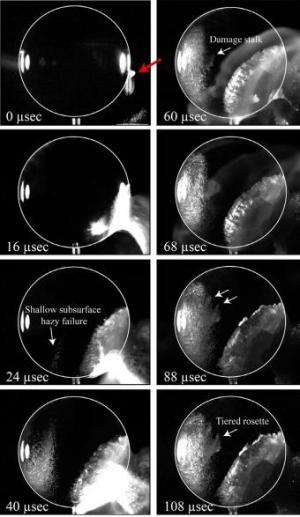How a giant impact formed asteroid Vesta's 'belt'

When NASA's Dawn spacecraft visited the asteroid Vesta in 2011, it showed that deep grooves that circle the asteroid's equator like a cosmic belt were probably caused by a massive impact on Vesta's south pole. Now, using a super high-speed cannon at NASA's Ames Research Center, Brown University researchers have shed new light on the violent chain of events deep in Vesta's interior that formed those surface grooves, some of which are wider than the Grand Canyon.
"Vesta got hammered," said Peter Schultz, professor of earth, environmental, and planetary sciences at Brown and the paper's senior author. "The whole interior was reverberating, and what we see on the surface is the manifestation of what happened in the interior."
The research suggests that the Rheasilvia basin on Vesta's south pole was created by an impactor that came in at an angle, rather than straight on. But that glancing blow still did an almost unimaginable amount of damage. The study shows that just seconds after the collision, rocks deep inside the asteroid began to crack and crumble under the stress. Within two minutes major faults reached near the surface, forming deep the canyons seen today near Vesta's equator, far from the impact point.
The research, led by Angela Stickle, a former graduate student at Brown and now a researcher at the Johns Hopkins University Applied Physics Laboratory, will appear in the February issue of the journal Icarus and is now available online.
"As soon as Pete and I saw the images coming down from the Dawn mission at Vesta, we were really excited," Stickle said. "The large fractures looked just like things we saw in our experiments. So we decided to look into them in more detail, and run the models, and we found really interesting relationships."
For the study, the researchers used the Ames Vertical Gun Range, a cannon with a 14-foot barrel used to simulate collisions on celestial bodies. The gun uses gunpowder and compressed hydrogen gas to launch projectiles at blinding speed, up to 16,000 miles per hour. For this latest research, Schultz and his colleagues launched small projectiles at softball-sized spheres made of an acrylic material called PMMA. When struck, the normally clear material turns opaque at points of high stress. By watching the impact with high-speed cameras that take a million shots per second, the researchers can see how these stresses propagate through the material.
The experiments showed that that damage from the impact starts where one would expect: at the impact point. But shortly after, failure patterns begin to form inside the sphere, opposite the point of impact. Those failures grow inward toward the sphere's center and then propagate outward toward the edges of the sphere like a blooming flower.
Using numerical models to scale the lab collision up to the size of Vesta, the second-largest object in the asteroid belt, the researchers showed that the outward-blooming "rosette" of damage extending to the surface is responsible for the troughs that form a belt around Vesta's equator.
The results answer some questions about Vesta's belt that had long been puzzling. Chief among them is the orientation of the belt with respect to the crater. The belt's angle isn't exactly what would be expected if it were caused by the Rheasilvia impact.
"The belt is askew," Schultz said, "as if Vesta were making a fashion statement."
These new experiments suggest that the crooked belt is the result of the angle of impact. An oblique impact causes the damage plane to be tilted with respect the crater. The orientation of Vesta's belt sheds light on the nature of the impact. The researchers conclude that the object that created Rheasilvia came in at an angle less than 40 degrees, traveling at about 11,000 miles per hour.
"Vesta was lucky," Schultz said. "If this collision had been straight on, there would have been one less large asteroid and only a family of fragments left behind."
The research shows that even a glancing blow can have tremendous consequences.
"When big things happen to small bodies," Schultz said, "it shakes them to the core."
More information: "Subsurface Failure in Spherical Bodies: A Formation Scenario for Linear Troughs on Vesta's Surface," A. M. Stickle, P. H. Schultz, and D. A. Crawford, Icarus, 2015 February, Vol. 247 dx.doi.org/10.1016/j.icarus.2014.10.002
Journal information: Icarus
Provided by Brown University





















